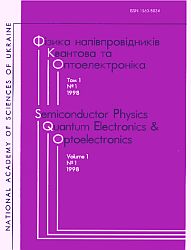

 | Наукова періодика України | 
| Semiconductor physics, quantum electronics & optoelectronics |
Kavetskyy T. S. Comments on the "Metallic nanoparticles (Cu, Ag, Au) in chalcogenide and oxide glassy matrices …” / T. S. Kavetskyy, A. L. Stepanov // Semiconductor physics, quantum electronics & optoelectronics. - 2017. - Vol. 20, № 4. - С. 481-482. - Режим доступу: http://nbuv.gov.ua/UJRN/MSMW_2017_20_4_16 Recently, in the work [1], restricted information collected from our references [2-4] was used for speculative and wrong conclusions based on this incorrectness and published for understanding the metal nanoparticles (MNPs) formation in chalcogenide and oxide glassy matrices. In particular, the authors of this work [1] have made some misleading opinions on the some statements which are not presented in our cited papers. First of all, the statement mentioned in the work [1] "...They asserted that Cu MNPs could be gathered in spherical entities of only 5 to 10 nm in radius, giving essential changes in optical linear absorption at the wavelenghts 580 - 590 nm and response in nonlinear optical properties observed in Z-scan measurements..." has been not reported in the publications [2-4]. If some opinion regarding the size of ion-synthesized Cu nanoparticles in chalcogenide glasses was noted by the authors [2-4] in other publications (e.g., abstracts or conference materials), it could be only as assumption but not as assertion. In order to make such assertion on the size of MNPs as in our case, the optical linear absorption data are not enough. Therefore, our experiments with ion-implanted chalcogenide glasses are currently in progress to get more microscopy information. Besides, a comparison of 40 keV Cu<^>+ Цитованість авторів публікації: Бібліографічний опис для цитування: Kavetskyy T. S. Comments on the "Metallic nanoparticles (Cu, Ag, Au) in chalcogenide and oxide glassy matrices …” / T. S. Kavetskyy, A. L. Stepanov // Semiconductor physics, quantum electronics & optoelectronics. - 2017. - Vol. 20, № 4. - С. 481-482. - Режим доступу: http://nbuv.gov.ua/UJRN/MSMW_2017_20_4_16. |
|
|
Всі права захищені © Національна бібліотека України імені В. І. Вернадського |
|||||